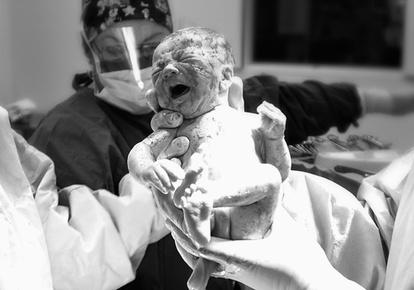You knew it would happen eventually. After many months, you arrive at the end of your pregnancy. Thoughts of labor and delivery may preoccupy your mind during the final weeks of your pregnancy. Although you may have your baby’s name picked out, his nursery decorated and your hospital bag packed, you may wonder how your labor will progress, once it begins. Knowing what to expect during your labor can help you understand what your body and your baby are going through during this exciting time.
Imminent Labor
Although not a true stage of labor, certain signs and symptoms near the end of your pregnancy can alert you to your baby’s impending birth. Many women notice a burst of energy and an impulse to clean or cook, according to the U.S. Department of Health and Human Services. Your baby may sink lower into your pelvis, a symptom referred to as “dropping.” Not all women notice these changes prior to the onset of labor.
First Stage
The first stage of labor begins with productive contractions. Although you may experience occasional uterine contractions throughout your pregnancy, active labor differs from these practice contractions. Contractions during the first stage of labor cause your cervix to thin and dilate. The longest stage of labor, this can take anywhere from several hours to several days. This stage usually takes less time during subsequent deliveries. During this stage, you may notice the appearance of a thick discharge from your vagina. You may want to use this time to take a short walk, watch a movie or continue your normal household activities. You might enjoy a shower or gentle massage while waiting for your labor to progress. As this stage progresses, your contractions become stronger and closer together. Your doctor will tell you when you should arrive at the hospital to check in and get ready for the birth of your baby. Your water may rupture naturally during this stage or your doctor or midwife may puncture the membranes.
Second Stage
This is what you have been waiting for during all these months. The second stage of labor brings your baby out of your body and into the world. This stage can require a matter of minutes to several hours to complete. Your doctor or midwife will tell you when to begin pushing. Your strong, regular contractions help bring the baby down the birth canal. This requires plenty of work and may make you feel exhausted. This is where your husband or coach can offer support and encouragement. Your medical professional may perform an episiotomy, a small cut to enlarge the vaginal opening, during this stage of labor. You may need to stop pushing as your baby begins emerging, while your doctor checks the cord and suctions your baby’s airway.
Third Stage
Although not an exciting stage for most new mothers, this stage continues to empty your uterus of the placenta, often referred to as the afterbirth. You may remember little about the third stage of labor as you focus on your newborn child. This short stage of labor usual lasts less than 30 minutes and ends in the delivery of the placenta. Your doctor might want to examine the placenta and repair you upon completion of this stage.
Photo Credit
- birth of a baby image by Steve Lovegrove from Fotolia.com





